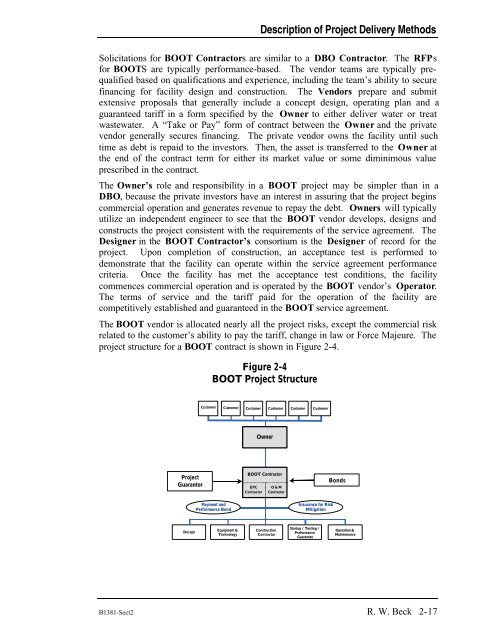Alternative Project Delivery - Texas Water Development Board
Alternative Project Delivery - Texas Water Development Board
Alternative Project Delivery - Texas Water Development Board
Create successful ePaper yourself
Turn your PDF publications into a flip-book with our unique Google optimized e-Paper software.
Description of <strong>Project</strong> <strong>Delivery</strong> Methods<br />
Solicitations for BOOT Contractors are similar to a DBO Contractor. The RFPs<br />
for BOOTS are typically performance-based. The vendor teams are typically prequalified<br />
based on qualifications and experience, including the team’s ability to secure<br />
financing for facility design and construction. The Vendors prepare and submit<br />
extensive proposals that generally include a concept design, operating plan and a<br />
guaranteed tariff in a form specified by the Owner to either deliver water or treat<br />
wastewater. A “Take or Pay” form of contract between the Owner and the private<br />
vendor generally secures financing. The private vendor owns the facility until such<br />
time as debt is repaid to the investors. Then, the asset is transferred to the Owner at<br />
the end of the contract term for either its market value or some diminimous value<br />
prescribed in the contract.<br />
The Owner’s role and responsibility in a BOOT project may be simpler than in a<br />
DBO, because the private investors have an interest in assuring that the project begins<br />
commercial operation and generates revenue to repay the debt. Owners will typically<br />
utilize an independent engineer to see that the BOOT vendor develops, designs and<br />
constructs the project consistent with the requirements of the service agreement. The<br />
Designer in the BOOT Contractor’s consortium is the Designer of record for the<br />
project. Upon completion of construction, an acceptance test is performed to<br />
demonstrate that the facility can operate within the service agreement performance<br />
criteria. Once the facility has met the acceptance test conditions, the facility<br />
commences commercial operation and is operated by the BOOT vendor’s Operator.<br />
The terms of service and the tariff paid for the operation of the facility are<br />
competitively established and guaranteed in the BOOT service agreement.<br />
The BOOT vendor is allocated nearly all the project risks, except the commercial risk<br />
related to the customer’s ability to pay the tariff, change in law or Force Majeure. The<br />
project structure for a BOOT contract is shown in Figure 2-4.<br />
Figure 2-4<br />
BOOT <strong>Project</strong> Structure<br />
Customer<br />
Customer Customer Customer Customer Customer<br />
Owner<br />
<strong>Project</strong><br />
Guarantor<br />
BOOT Contractor<br />
EPC<br />
Contractor<br />
O & M<br />
Contractor<br />
Bonds<br />
Payment and<br />
Performance Bond<br />
Insurance for Risk<br />
Mitigation<br />
Design<br />
Equipment &<br />
Technology<br />
Construction<br />
Contractor<br />
Startup / Testing /<br />
Performance<br />
Guarantee<br />
Operation &<br />
Maintenance<br />
B1381-Sect2 R. W. Beck 2-17
















